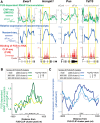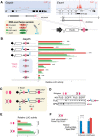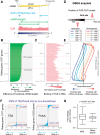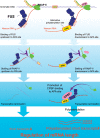Position-specific binding of FUS to nascent RNA regulates mRNA length
- PMID: 25995189
- PMCID: PMC4441052
- DOI: 10.1101/gad.255737.114
Position-specific binding of FUS to nascent RNA regulates mRNA length
Abstract
More than half of all human genes produce prematurely terminated polyadenylated short mRNAs. However, the underlying mechanisms remain largely elusive. CLIP-seq (cross-linking immunoprecipitation [CLIP] combined with deep sequencing) of FUS (fused in sarcoma) in neuronal cells showed that FUS is frequently clustered around an alternative polyadenylation (APA) site of nascent RNA. ChIP-seq (chromatin immunoprecipitation [ChIP] combined with deep sequencing) of RNA polymerase II (RNAP II) demonstrated that FUS stalls RNAP II and prematurely terminates transcription. When an APA site is located upstream of an FUS cluster, FUS enhances polyadenylation by recruiting CPSF160 and up-regulates the alternative short transcript. In contrast, when an APA site is located downstream from an FUS cluster, polyadenylation is not activated, and the RNAP II-suppressing effect of FUS leads to down-regulation of the alternative short transcript. CAGE-seq (cap analysis of gene expression [CAGE] combined with deep sequencing) and PolyA-seq (a strand-specific and quantitative method for high-throughput sequencing of 3' ends of polyadenylated transcripts) revealed that position-specific regulation of mRNA lengths by FUS is operational in two-thirds of transcripts in neuronal cells, with enrichment in genes involved in synaptic activities.
Keywords: CLIP; FUS; RNA polymerase II; alternative polyadenylation; mRNA length.
© 2015 Masuda et al.; Published by Cold Spring Harbor Laboratory Press.
Figures







Similar articles
-
FUS-mediated regulation of alternative RNA processing in neurons: insights from global transcriptome analysis.Wiley Interdiscip Rev RNA. 2016 May;7(3):330-40. doi: 10.1002/wrna.1338. Epub 2016 Jan 28. Wiley Interdiscip Rev RNA. 2016. PMID: 26822113 Review.
-
tRIP-seq reveals repression of premature polyadenylation by co-transcriptional FUS-U1 snRNP assembly.EMBO Rep. 2020 May 6;21(5):e49890. doi: 10.15252/embr.201949890. Epub 2020 Mar 18. EMBO Rep. 2020. PMID: 32189459 Free PMC article.
-
Six GU-rich (6GUR) FUS-binding motifs detected by normalization of CLIP-seq by Nascent-seq.Gene. 2017 Jun 30;618:57-64. doi: 10.1016/j.gene.2017.04.008. Epub 2017 Apr 7. Gene. 2017. PMID: 28392367
-
FUS binds the CTD of RNA polymerase II and regulates its phosphorylation at Ser2.Genes Dev. 2012 Dec 15;26(24):2690-5. doi: 10.1101/gad.204602.112. Genes Dev. 2012. PMID: 23249733 Free PMC article.
-
Implications of polyadenylation in health and disease.Nucleus. 2014;5(6):508-19. doi: 10.4161/nucl.36360. Epub 2014 Oct 31. Nucleus. 2014. PMID: 25484187 Free PMC article. Review.
Cited by
-
Faulty RNA splicing: consequences and therapeutic opportunities in brain and muscle disorders.Hum Genet. 2017 Sep;136(9):1215-1235. doi: 10.1007/s00439-017-1802-y. Epub 2017 Apr 22. Hum Genet. 2017. PMID: 28434044 Review.
-
Crosstalk between RNA-binding proteins and non-coding RNAs in tumors: molecular mechanisms, and clinical significance.Int J Biol Sci. 2025 Apr 21;21(7):2991-3010. doi: 10.7150/ijbs.109593. eCollection 2025. Int J Biol Sci. 2025. PMID: 40384875 Free PMC article. Review.
-
Molecular determinants of cytochrome C oxidase IV mRNA axonal trafficking.Mol Cell Neurosci. 2017 Apr;80:32-43. doi: 10.1016/j.mcn.2017.01.008. Epub 2017 Feb 1. Mol Cell Neurosci. 2017. PMID: 28161363 Free PMC article.
-
Mutant FUS and ELAVL4 (HuD) Aberrant Crosstalk in Amyotrophic Lateral Sclerosis.Cell Rep. 2019 Jun 25;27(13):3818-3831.e5. doi: 10.1016/j.celrep.2019.05.085. Cell Rep. 2019. PMID: 31242416 Free PMC article.
-
Mechanism of STMN2 cryptic splice-polyadenylation and its correction for TDP-43 proteinopathies.Science. 2023 Mar 17;379(6637):1140-1149. doi: 10.1126/science.abq5622. Epub 2023 Mar 16. Science. 2023. PMID: 36927019 Free PMC article.
References
-
- Bataille AR, Jeronimo C, Jacques PE, Laramee L, Fortin ME, Forest A, Bergeron M, Hanes SD, Robert F. 2012. A universal RNA polymerase II CTD cycle is orchestrated by complex interplays between kinase, phosphatase, and isomerase enzymes along genes. Mol Cell 45: 158–170. - PubMed
Publication types
MeSH terms
Substances
Associated data
LinkOut - more resources
Full Text Sources
Other Literature Sources
Molecular Biology Databases
Miscellaneous
